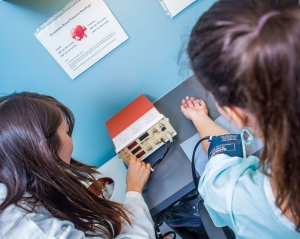From Brazilian ghettos to the penthouses of Manhattan’s Upper East Side, McGrath has also discovered that in most communities, rich or poor, you’ll find some people who rank themselves as higher status, some lower and some in-between. Like many other researchers, to measure this relative status she uses a “subjective socioeconomic status measuring tool” that is, simply, a 10-rung ladder. Each person marks where on the ladder he or she thinks they fall compared to others in society.
McGrath recalls research she conducted as an intern in New York City. “There were people who were so well off they had private jets, yet I remember one child thought they were not well-to-do because they didn’t also have a helicopter. It was really striking.”
In contrast, in 2010 McGrath visited Brazil for the annual meeting of the International Network of Research in Inequalities in Child Health. “We had a chance to witness the dire slums of Brazil,” she recalls. “It’s a sea of makeshift homes made with corrugated cardboard and plywood, crowded and covered with dirt and mud.”
At a conference later that year, McGrath met a researcher who had gotten people from these slums to complete the 10-rung ladder test. “I was struck by the results and by the resilience of these individuals, who by all standards would meet extreme poverty criteria yet ranked themselves across the entire ladder, characteristic of the typical ‘bell curve’ often found in social sciences.”
Inspiration struck. She says: “What was it about some of these individuals who could look around them, amid the disorder, uncleanliness, laundry lines and broken windows, and still believe they were better off than others? This was a human phenomenon in which their happiness and well-being transcended their material goods. What was behind this? What is it about one’s perception of status that seems to trump objective socioeconomic status? And how might this help us better understand –– and level –– socioeconomic gradients in health?”
The link between social inequality and health is also a research topic of Richard Wilkinson and Kate Pickett. On June 26, the British authors of The Spirit Level: Why Equality Is Better for Everyone and co-founders of the Equality Trust spoke at Concordia’s International Network for Research on Inequalities in Child Health Workshop, hosted by McGrath.
“The most important sources of chronic stress seem to be those worries about how you’re seen and judged,” says Wilkinson, professor emeritus of Social Epidemiology at the University of Nottingham Medical School. He regards social status, friendship and early childhood as key factors in long-term health. “Those three factors are, in a way, all about whether you’re valued or not,” he says. “Studies show that what really pushes up levels of stress hormones are situations where there is a strong ‘social evaluative threat’: threats to self-esteem or social status where you can be judged negatively by others.”
McGrath’s data supports the value of social capital — the social connection one has with his or her neighbourhood and environment. “Having a community you feel connected to, and you’re part of that community, is critical to well-being,” she says.
While our individual health choices certainly make an impact, McGrath’s findings also demonstrate the significance of social factors. During her postdoctoral training at the University of Pittsburgh, McGrath understood that making healthy choices can be challenging “when inequalities are ingrained or sustained.”
To supplement her stipend, she worked for a mental health service that provided help to low-income families in their homes. “The gap of the economic and social patterning in Pittsburgh was remarkable, with neighbourhoods that were extremely wealthy or extremely poor,” she says. “I was assigned a case in the Hill District, a poor, high-crime neighbourhood with most properties vacant, covered with graffiti, windows boarded up, broken glass and abandoned cars missing removable parts.” In the home, she reports, “I needed to start at a very practical level. Dinner was often McDonald’s or popsicle squeeze tubes.”
One day, as she was leaving for another appointment, “I asked where I could get take-out, or pick up some food,” she says. “And this is what struck me most: they explained that I could choose from hot dogs at the corner store –– the ones rotating on the metal cylinders covered in oil, but if I wanted other food I would need to drive to another store.”
Since nobody had cars, McGrath asked how they got food. “They took three buses to a grocery store that had awful produce and that was extremely expensive. It made real sense why no one would go through that much effort to get healthy food when the environment around them made it difficult to make healthy choices regarding lifestyle behaviours.” McGrath will be investigating how neighbourhood factors contribute to children’s lifestyle behaviours as part of her most recent grant funded by CIHR, through her work with PERFORM Centre researcher Tracie Barnett, an associate professor in Concordia’s Department of Exercise Science.


 Jennifer McGrath’s research has made headlines in the Montreal Gazette andTime magazine.
Jennifer McGrath’s research has made headlines in the Montreal Gazette andTime magazine.
 Jennifer McGrath (right), director of Concordia’s pediatric public health psychology laboratory, is among the top five per cent of funded researchers in Canada.
Jennifer McGrath (right), director of Concordia’s pediatric public health psychology laboratory, is among the top five per cent of funded researchers in Canada.
 Research at the pediatric public health psychology laboratory includes using sleep monitors, like the one pictured above, to monitor connections between childhood stress and shorter sleep duration.
Research at the pediatric public health psychology laboratory includes using sleep monitors, like the one pictured above, to monitor connections between childhood stress and shorter sleep duration.
 Concordia’s Pediatric Public Health Psychology (PPHP) Laboratory
Concordia’s Pediatric Public Health Psychology (PPHP) Laboratory